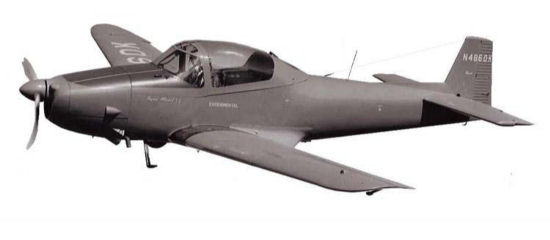
The home of everything related to Twin Navion and Camair aircraft

- Home
- News
- Navion History
- Types of Navions
- Individual Aircraft Histories
- Database
- Stories
- Maintenance Resources
- Manufacturer's Brochures
- Publications
- Models
- Toys
- Collector Cards
- Flight Simulation
- Marketplace
- Links

Download three-view drawings of the Model 72 Navion. Click here and here.
The Model 72 was originally built by the Ryan Aeronautical Company in 1949, as a standard 205hp Navion A, but the airframe
never received a normal certification. Instead it was used as a flying test bed for options and modifications that Ryan
planned on introducing into the production line. Among the changes was the installation of a 260hp geared Lycoming engine,
which became standard in the Navion B.
In 1952 Ryan began working on an entry into the US Navy's primary trainer competition. Naturally N4860K became the
prototype for the project. Numerous changes were made, including the reinforcement of the wing and fuselage for +9/-4Gs,
structural elliptical wingtip extensions, a free castoring nose wheel, differential braking, toe brakes, two fixed pilot's
seats, adjustable rudder pedals, replacement of the control yolks with sticks, a redesigned instrument panel and throttle
quadrant, and the installation of two large skylights in the sliding canopy.
The large wingtips were needed to make the Navion spin, but this created stability problems. The solution was to remove the
Navion's standard fin extension. And because aerobatic maneuvers would become standard, the variable pitch propeller now
required a governor.
In 1953 the Model 72 began a series of test flights in California and then flew to the US Naval Air Station in Pensacola,
Florida for the Navy evaluation. For three months, from late September to early December the Model 72 was tested against
entries from Beech and TEMCO, and by all accounts, performed well. Some considered too stable. Other shortcomings included
the greenhouse canopy, whose framing impeded visibility. The solution was to make a new canopy from half-inch thick
Plexiglas.
During the US Navy's evaluation, the US Navy the Model 72 and the other competitors were put through a series of tests,
including a period of use by actual students and instructors. Twelve student pilots from various backgrounds, including the
US Marine Corps., were partnered with four instructors. The students were broken into groups of four, and assigned to a
specific trainer. The instructors were rotated between planes to gather comments from experienced pilots.
The students knew they were part of the trainer's evaluation, and most of their flight training, and all of their ground
training was to be performed on the North American SNJ - the Navy's standard trainer.
Naturally Ryan put a great deal of effort into promoting the Model 72's side-by-side seating arrangement. This arrangement
was preferred by both instructors and students as it allowed them to see and show each other's actions.
Spins and aerobatic flight was common during flight training, although at least one student commented that the Model 72 was,
"too stable, and you had to work at spins, etc."
In the end, the US Navy selected the Beech T-34 Mentor as their primary trainer. Some attribute this decision to Ryan
already having military contracts for experimental V/STOL aircraft. Logically, Beech was already producing the Mentor for
the US Air Force, and inter-service commonality was probably a major factor in the competition's outcome.
Following the competition N4860K returned to Ryan and spent the next 10 years operating as a chase plane during the
company's vertical and STOL aircraft programs. It was also used during the early Firebee drone programs. In 1962 the
decision was made to sell the Model 72 on the civil market. This was unusual as most x-planes are simply scrapped or placed
in museums. Instead the Navion was paint stripped, and given a conventional white and black color scheme.
Note: Many people and publications refer to the Model 72 as the Navion C. This is not the case. The C model designation
was never officially assigned to any Navion and is therefore nothing more than a gap in the designation sequence.